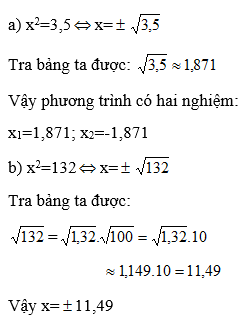Hãy nhập câu hỏi của bạn vào đây, nếu là tài khoản VIP, bạn sẽ được ưu tiên trả lời.

a)
5x2−3x=0⇔x(5x−3)=05x2−3x=0⇔x(5x−3)=0
⇔ x = 0 hoặc 5x – 3 =0
⇔ x = 0 hoặc x=35.x=35. Vậy phương trình có hai nghiệm: x1=0;x2=35x1=0;x2=35
Δ=(−3)2−4.5.0=9>0√Δ=√9=3x1=3+32.5=610=35x2=3−32.5=010=0Δ=(−3)2−4.5.0=9>0Δ=9=3x1=3+32.5=610=35x2=3−32.5=010=0
b)
3√5x2+6x=0⇔3x(√5x+2)=035x2+6x=0⇔3x(5x+2)=0
⇔ x = 0 hoặc √5x+2=05x+2=0
⇔ x = 0 hoặc x=−2√55x=−255
Vậy phương trình có hai nghiệm: x1=0;x2=−2√55x1=0;x2=−255
Δ=62−4.3√5.0=36>0√Δ=√36=6x1=−6+62.3√5=06√5=0x2=−6−62.3√5=−126√5=−2√55Δ=62−4.35.0=36>0Δ=36=6x1=−6+62.35=065=0x2=−6−62.35=−1265=−255
c)
2x2+7x=0⇔x(2x+7)=02x2+7x=0⇔x(2x+7)=0
⇔ x = 0 hoặc 2x + 7 = 0
⇔ x = 0 hoặc x=−72x=−72
Vậy phương trình có hai nghiệm: x1=0;x2=−72x1=0;x2=−72
Δ=72−4.2.0=49>0√Δ=√49=7x1=−7+72.2=04=0x2=−7−72.2=−144=−72Δ=72−4.2.0=49>0Δ=49=7x1=−7+72.2=04=0x2=−7−72.2=−144=−72
d)
2x2−√2x=0⇔x(2x−√2)=02x2−2x=0⇔x(2x−2)=0
⇔ x = 0 hoặc 2x−√2=02x−2=0
⇔ x = 0 hoặc x=√22x=22
Δ=(−√2)2−4.2.0=2>0√Δ=√2x1=√2+√22.2=2√24=√22x2=√2−√22.2=04=0

a, \(\Delta=25-8=17\)>0 Vậy pt có 2 nghiệm pb
\(x=\dfrac{5\pm\sqrt{17}}{4}\)
b, \(\Delta=16-16=0\)Vậy pt có nghiệm kép
\(x_1=x_2=\dfrac{1}{4}\)
c, \(\Delta=1-4.2.5< 0\)Vậy pt vô nghiệm
d, \(\Delta=4+4.24=100>0\)Vậy pt có 2 nghiệm pb
\(x=\dfrac{-2-10}{-6}=2;x=\dfrac{-2+10}{-6}=-\dfrac{4}{3}\)

\(x^2-6x+9=0\) (1)
\(\Leftrightarrow\left(x-3\right)^2=0\)
\(\Leftrightarrow x-3=0\)
\(\Leftrightarrow x=3\)
Vậy tập nghiệm của phương trình (1) là \(S=\left\{3\right\}\)
\(x^3-6x^2+11x-6=0\)
\(\Leftrightarrow\left(x^3-3x^2\right)-\left(3x^2-9x\right)+\left(2x-6\right)=0\)
\(\Leftrightarrow x^2\left(x-3\right)-3x\left(x-3\right)+2\left(x-3\right)=0\)
\(\Leftrightarrow\left(x-3\right)\left(x^2-3x+2\right)=0\)
\(\Leftrightarrow\left(x-3\right)\left(x-1\right)\left(x-2\right)=0\)
\(\Leftrightarrow\)\(x=3\)
hoặc \(x=1\)
hoặc \(x=2\)
Vậy tập nghiệm của phương trình (2) là \(S=\left\{1;2;3\right\}\)
Mà 2 phương trình trên có 1 nghiệm chung
\(\Rightarrow\)Tập nghiệm của 2 phương trình là \(S=\left\{3\right\}\)

Gọi x1,x2x1,x2 là nghiệm của x2−mx−2=0(1)x2−mx−2=0(1)
→{x1+x2=mx1x2=−2→{x1+x2=mx1x2=−2
→⎧⎪ ⎪⎨⎪ ⎪⎩1x1+1x2=x1+x2x1x2=−m21x1.1x2=−12→{1x1+1x2=x1+x2x1x2=−m21x1.1x2=−12
→1x1,1x2→1x1,1x2 là nghiệm của phương trình
x2+m2x−12=0

a) Dùng hệ thức Viét ta có:
\(x_1x_2=\dfrac{-35}{1}=-35\\ \Leftrightarrow7x_2=-35\\ \Leftrightarrow x_2=-5\\ x_1+x_2=\dfrac{-m}{1}=-m\\ \Leftrightarrow7+\left(-5\right)=-m\\ \Leftrightarrow-m=2\\ \Leftrightarrow m=-2\)
b) Dùng hệ thức Viét ta có:
\(x_1+x_2=\dfrac{-\left(-13\right)}{1}=13\\ \Leftrightarrow12,5+x_2=13\\ \Leftrightarrow x_2=0,5\\ x_1x_2=\dfrac{m}{1}=m\\ \Leftrightarrow12,5\cdot0,5=m\\ \Leftrightarrow m=6,25\)
c) Dùng hệ thức Viét ta có:
\(x_1+x_2=\dfrac{-3}{4}\\ \Leftrightarrow-2+x_2=\dfrac{-3}{4}\\ \Leftrightarrow x_2=\dfrac{5}{4}\\ x_1x_2=\dfrac{-m^2+3m}{4}\\ \Leftrightarrow4x_1x_2=-m^2+3m\\ \Leftrightarrow4\cdot\left(-2\right)\cdot\dfrac{5}{4}+m^2-3m=0\\ \Leftrightarrow m^2-3m-10=0\\ \Leftrightarrow m^2-5m+2m-10=0\\ \Leftrightarrow m\left(m-5\right)+2\left(m-5\right)=0\\ \Leftrightarrow\left(m+2\right)\left(m-5\right)=0\\ \Leftrightarrow\left[{}\begin{matrix}m=-2\\m=5\end{matrix}\right.\)
d) Dùng hệ thức Viét ta có:
\(x_1x_2=\dfrac{5}{3}\\ \Leftrightarrow\dfrac{1}{3}x_2=\dfrac{5}{3}\\ \Leftrightarrow x_2=5\\ x_1+x_2=\dfrac{-\left[-2\left(m-3\right)\right]}{3}=\dfrac{2\left(m-3\right)}{3}=\dfrac{2m-6}{3}\\ \Leftrightarrow3\left(x_1+x_2\right)=2m-6\\ \Leftrightarrow3\left(\dfrac{1}{3}+5\right)=2m-6\\ \Leftrightarrow3\cdot\dfrac{16}{3}+6=2m\\ \Leftrightarrow16+6=2m\\ \Leftrightarrow22=2m\\ \Leftrightarrow m=11\)

a = 1 , b = - ( 2m + 1 ) , c = m - 3
\(\Delta=b^2-4ac\)
\(=\left[-\left(2m+1\right)\right]^2-4.1.\left(m-3\right)\)
\(=4m^2+4m+1-4m+12\)
\(=4m^2+13>0\forall m\)
Vậy: Pt (1) luôn có 2 nghiệm phân biệt với mọi m
Theo Vi-et ta có: \(P=x_1x_2=\frac{c}{a}=m-3\)
\(A=3x_1x_2-2x_1x_2\ge4\)
\(A=3P-2P\ge4\)
\(A=P=m-3\ge4\Leftrightarrow m\ge7\)

Phương trình bậc hai 6x2 + x + 5 = 0
Có a = 6; b = 1; c = 5; Δ = b2 – 4ac = 12 – 4.5.6 = -119 < 0
Vậy phương trình vô nghiệm.